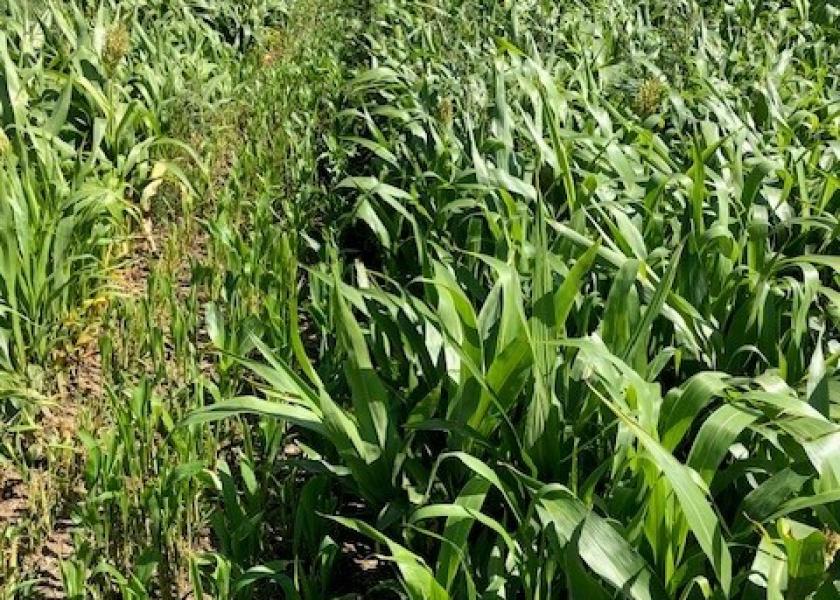Take Precautions Against Toxicity of Sorghum Forages

Temperatures are trending down across the Northern Plains and will fluctuate up and down as we head closer to winter. These temperature fluctuations cause stress on sorghum plants, which can lead to toxicity issues for livestock.
“The sorghum family of plants contains hydrocyanic acid (prussic acid) attached to a molecule of dhurrin,” says James Rogers, North Dakota State University Extension forage systems specialist. “The dhurrin molecule releases prussic acid when the plant is stressed. Stress factors, including drought, grazing, chemical applications and frost, can crush plant cells or cause them to rupture, triggering an enzymatic reaction and a release of prussic acid. When prussic acid develops, concentrations are highest in new, rapidly growing leaf tissue, and higher in leaves than stems, creating a hazard for grazing cattle.”
Once ingested by the animal, prussic acid blocks body cells from receiving oxygen. At this time of year, a light but not killing frost can cause the plant growth to cease but not kill the plant crown. The root crown then can still produce new shoots that can contain high levels of prussic acid.
“Cattle can detoxify a high percentage of low-level prussic acid exposure, but the high concentrations found in fresh regrowth following a stress period greatly increase risk,” says Karl Hoppe, NDSU Extension livestock systems specialist. “If cattle are grazing sorghum forages and frost warnings are in the forecast, ranchers should remove cattle until after a killing frost has completely killed the plant and residual growth has fully dried down. Complete dry down will usually take a week or more, depending on drying conditions. After the sorghums have completely dried down, ranchers can turn out cattle to graze out the sorghum as a standing hay crop.”
When sorghum plants are cut for hay, any prussic acid that might have been present at the time of cutting dissipates as the hay dries. The same is true for sorghums that have gone through an ensiling process. Prussic acid dissipates by the time the ensiling process has been completed. After sorghum has been ensiled, wait for a period of three weeks before feeding, Rogers says. This will give time for the ensiling process to complete and prussic acid to dissipate if it were present.
Fall can also be a period for increased accumulation of nitrates in sorghums. Following a hay harvest or grazing, the cool, cloudy temperatures typical of fall can cause nitrate accumulation in sorghum regrowth. Nitrate accumulation is highest in the stems of the plants rather than leaves, which is the opposite of prussic acid. Unlike with prussic acid, drying the forage for hay will not eliminate high levels of nitrate. Ensiling reduces levels by up to 50%, but if the initial nitrate level is high, even a 50% reduction may not reduce the concentrations to a safe feeding level for all livestock. Nitrate levels can be determined through testing, and test results can help ranchers develop management strategies for feeding. Contact your local NDSU Extension agent for information on free testing options.
Rogers and Hoppe recommend management strategies that can reduce the risks of grazing sorghums during periods of plant stress and potential prussic acid production.
- Avoid grazing sorghums following a period of light frost. Wait 7 to 10 days or more before grazing.
- If new shoot growth begins following a light frost, avoid grazing until regrowth is 18 to 24 inches tall or after a killing frost.
- Wait 7 to 10 days or more following a killing frost to allow time for prussic acid dissipation. Once the plants have completely dried, grazing can resume.
- Never turn hungry cattle on sorghums.
- Harvesting sorghum as hay or silage reduces prussic acid concentrations.
“Fall is a beautiful time of the year but it can cause stress on the sorghum family of forages,” says Rogers. “These plant stressors can lead to the development of prussic acid and/or nitrate accumulation. This is a cautionary tale, be aware of the conditions that can cause these anti-quality issues to develop and management strategies to overcome them when they do.”







